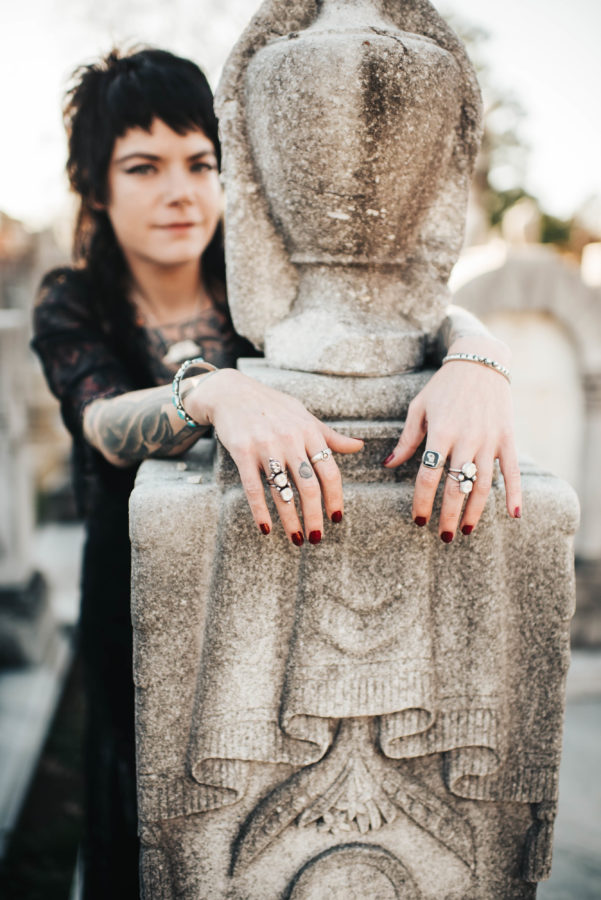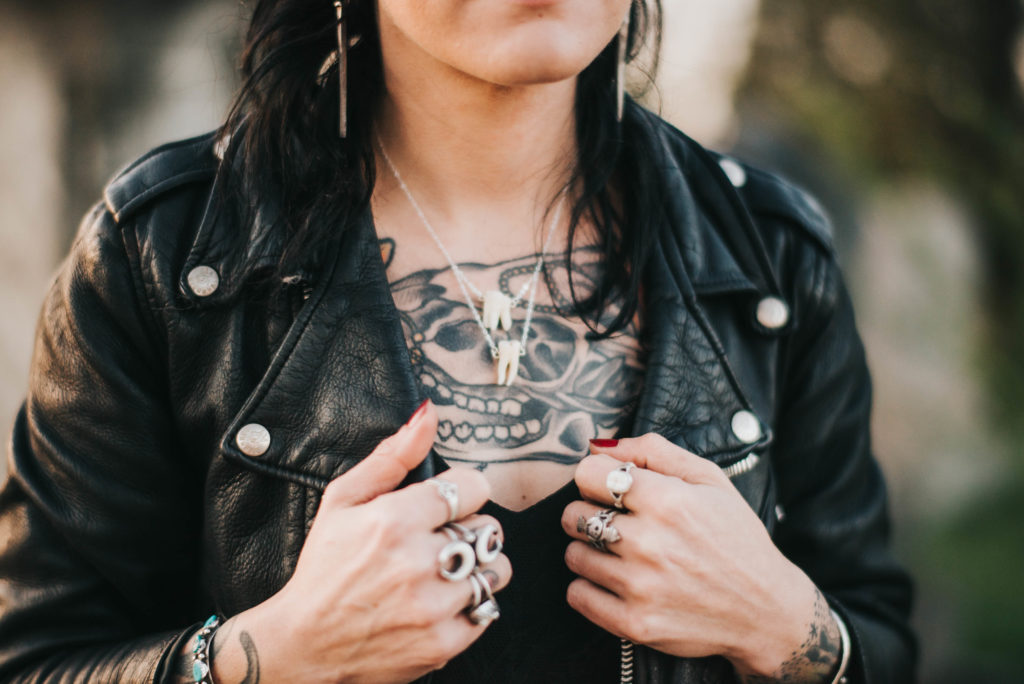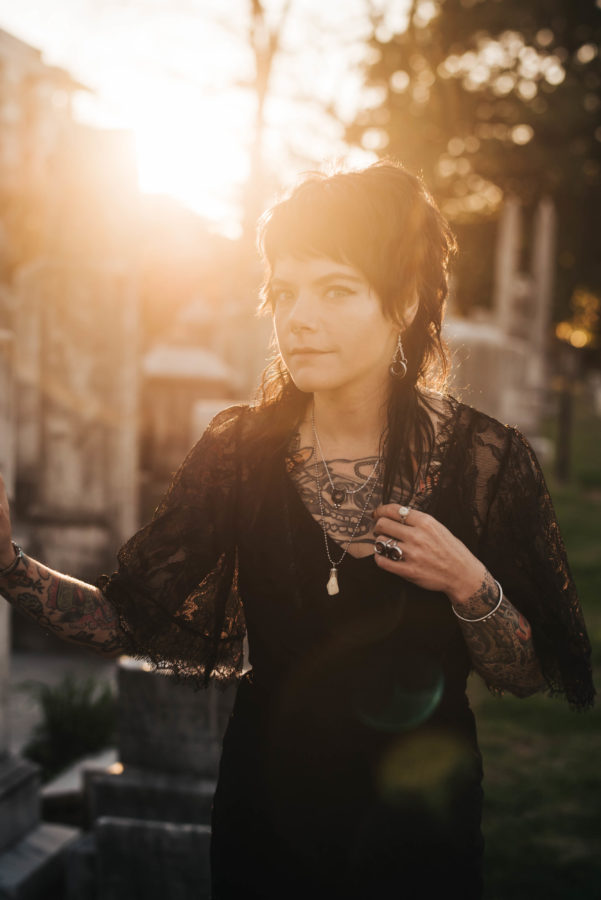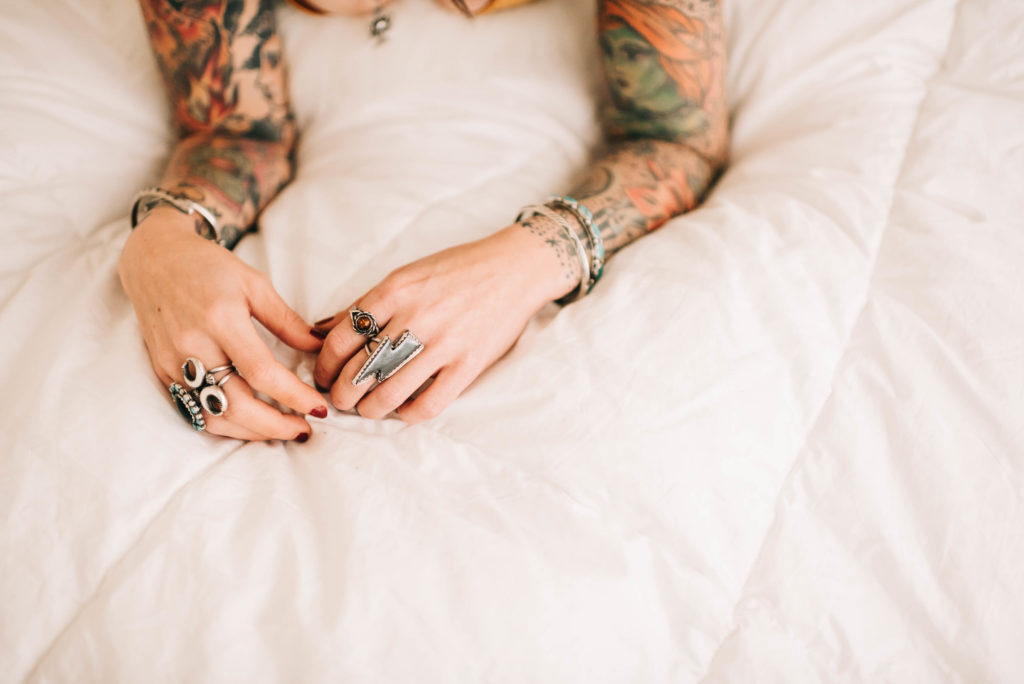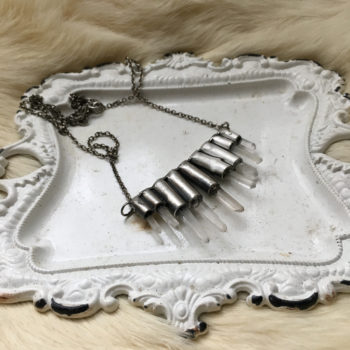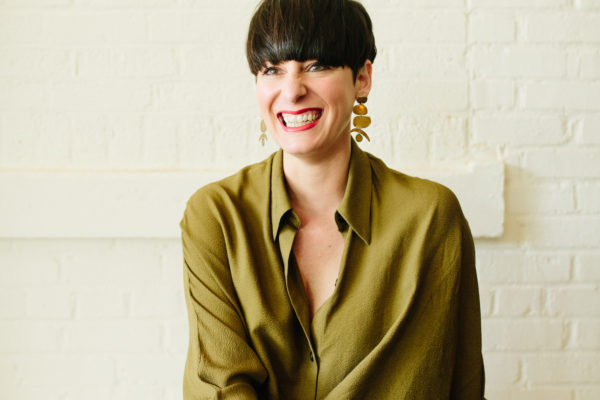Teeth and hair from humans are only some of the unique materials Atlanta metalsmith and jewelry maker Beena Miller likes to experiment with when making jewelry. (Yes, you read that right.)
Hailing from Virginia, Miller says she originally moved to Atlanta because of music, which is still a big part of her life — she’s also a tour manager for local bands. “I was driving down here from Virginia almost once a month for shows,” Miller says. But it was the creative scene that brought her to live here full-time.
Here, CommonCreativ ATL talks to Miller about what inspired her to first start creating nearly a decade ago, how death influences her designs, and what’s next for her.
CommonCreativ: How did you start making jewelry, and how long ago did you start?
Beena Miller: I’ve been crafty my entire life, but I started making jewelry to sell about seven years ago. Back then I didn’t have a very large skill set, so it was mostly like assemblage, putting teeth and bones on chains, gluing stones into premade rings, that sort of thing. At the time, I had a full-time job and they had cut my hours down to the minimum amount, so that’s what pushed me to open the Etsy shop and start selling things. Over time I’ve learned a lot of new skills and my jewelry has changed along with that.
I’ve been smithing now for a little more than three years. Around that time, it seemed like there was this explosion in the market and suddenly everyone was gluing animal teeth into bullet casings and selling them on Etsy to witchy girls, so I had sort of a decision moment where I could feel sorry for myself that everyone was doing what I was doing, or I could step up my game to something that not everyone could do.
CC: How did that change what you were doing?
BM: The first skill I added was electroforming with copper which makes this earthy, witchy looking jewelry. [It] was great when I was still working because you just leave something in the solution for eight hours for the copper skin to form on it. So, I would go to work and come back, and some jewelry would have made itself while I was gone. Eventually a lot of other people started electroforming too and I lost some of my feeling of connection to that medium because I made a lot of jewelry that way that I wouldn’t personally wear, and it was feeling kind of inauthentic to me. So, I came to the point again where I had to decide to push myself some more or just be mediocre again. That’s when I bought some supplies and a crappy propane torch and tried to smith. I’ve gotten a lot of those early pieces back for repair since then and man, I really made them wrong, but bless the patient people who let me fix that stuff for them.
CC: Your jewelry is so unique. What inspires your designs for Extollo Jewelry?
BM: My first love is the creepy stuff — that’s where I started. My biggest influence has always been Victorian mourning jewelry and imagery. Death was a huge part of life experience back then. They had all this culture and tradition around it that seems morbid to us now, but I’ve always found it to be sort of healthy and beautiful. After all, life would have a lot less value if it wasn’t a finite thing that ended — that’s part of what makes it so important that we live in a fulfilling way and appreciate the people around us and the experiences that we have.
The Victorians took death so seriously that they took photographs with the deceased and regularly set hair or teeth into jewelry and used skull and urn imagery as memorial or pieces or lover’s tokens. There’s even a pretty famous piece of lover’s jewelry set with a slice of someone’s amputated leg bone — very romantic. I was also strongly influenced by antique German Black Forest hunting trophies, which would have been the tooth or foot of something you hunted and killed set in sterling. I’m not a hunting fan, but those old jewelry pieces are so lovely. I really try to capture that balance that they have between macabre and beautiful when I’m working with the same types of materials.
I don’t only make creepy things though, lots of things inspire me. I’m bad at just sticking to one aesthetic all the time because I just get distracted by stuff I think is cool. My mother has collected Navajo jewelry my entire life, so I have some Southwestern influence in my work. I’ve done collections inspired by everything from ‘70s glam rock to Art Deco design to Elvis to tarot. I don’t really want to be pigeonholed into this corner of the market that is only witchy, or only oddities type stuff, because those aren’t the only things that I’m interested in.
CC: What are your favorite materials to use?
BM: My favorite metal to work with is silver. The most memorable and unique material that I work with a lot is human teeth. It’s interesting to me the way people react to that because there’s only two ways it ever goes which is thinking it’s disgusting and horrible and thinking that it’s awesome. It’s completely different than the way people react to seeing an animal tooth or claw in something. I think too there is a difference between what someone imagines when I say that I make jewelry from human teeth and when they see it and realize that it’s not like, a headhunter necklace or something, they’re quite beautiful. I like calling them human ivory.
I also love stones, just like any smith does. I like turquoise jewelry as much as the next person, but my favorite stones are metallic ones like pyrite and hematite. I just can’t get enough pyrite. A lot of times my creation process works backwards from the materials. Pieces are designed around the stones or other elements that I have, sort of like if a fashion designer bought fabric first and then designed the clothing to make out of it. I also have little sketchbooks all over my house, so I can scribble ideas and stuff as they come, which is usually right before I fall asleep or in the shower.
CC: What’s your creation process?
BM: As far as the actual production part of the process, it’s chaotic. I have barely-managed ADD so I’m usually working on about six pieces of jewelry at a time and only like two of them are things I’m “supposed” to be working on as part of an order or against a deadline or something.
CC: What are some of your favorite jewelry pieces to make?
BM: I think my favorite things to make are anything that pushes the boundaries of my skill limits. If I must solve a problem or do something I’ve never done before, I love that. I’m lucky to have a job that lets me do something that I truly enjoy all the time, but I don’t always get to take risks like that because time and money are so delicately balanced in a small business, but when I do, it’s fun.
CC: What is it about jewelry-making that you find most fulfilling?
BM: That I will never stop learning. There is no such thing as an expert at all types of jewelry fabrication. For every new skill I learn, there are 50 more I’ve never even tried, so I will never come to the end and I will never get bored. I’m also self-taught and I’m not sure there is a better feeling in the world than trying to figure out how to make something that you can envision in your mind and pulling it off.
CC: What have been some of your greatest artistic achievements?
BM: I didn’t really start thinking of my jewelry making as art instead of craft until I started smithing. Once you start to fabricate yourself, your vision is no longer limited by what you can put together from what is already there. You can make anything you can think up. I remember a couple years ago when people slowly started to refer to what I make as “your work” and “your art” and how happy it made me to feel that I had crossed that threshold. One of my best friends is a musician, and he says when he writes songs his goal is to be someone’s favorite band. I’ve had a couple tell me that pieces of mine are their favorite piece of jewelry or that I’m their favorite jeweler. I don’t think there is any higher artistic achievement than that.
CC: Where can locals find your stuff?
BM: I don’t have any jewelry in retail spots locally, so if you want to try some stuff on in person you’re just going to have to come talk to me! I do lots of local markets and popups around town including Holiday ICE, Dope Girls Market, Estoria Pop-Up, and Argosy Market. I try to be good about posting about them on my social media, so that’s the best way to find out where I’m going to be.
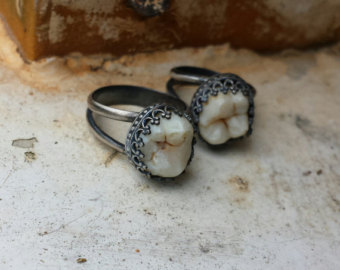 CC: How do you promote yourself?
CC: How do you promote yourself?
BM: It’s wild how different being an artist or craftsperson is now than it would have been even 10 years ago when you would have just worked with galleries or third parties to sell your stuff. Now, the artist is responsible for all their own selling and this branding and content creation and social media stuff that I kind of think I’m not even qualified for. I do get a lot of my business through Instagram, so I must be doing that at least sort of correctly. I’m also very lucky to travel a lot with bands and get my jewelry out there that way. I’m just waiting for some of these boys to make it big so I can be personal jeweler to the stars, you know? [Kiss guitarist and singer] Paul Stanley’s personal jeweler gets to go on cruises with them and stuff.
CC: What do you do when you’re not creating art?
BM: I don’t have a day job. My other job is as a tour manager for bands, my main gig being the Biters, who are Atlanta locals, but I fill in for a couple of other bands too sometimes. I do get to sell jewelry on tour, but aside from that those two parts of my life are at two extremes. So, I’m either on tour for weeks or months, talking to people constantly, trying to run a tour smoothly and sell merch and being at shows every night and not being alone 24 hours a day, or I’m off tour and home making jewelry and sometimes not having any contact with other people for days in a row. They sort of balance each other out nicely, and each one makes me miss the other.
CC: What do you think of Atlanta’s creative scene right now?
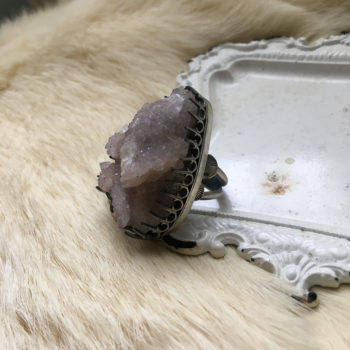 BM: I think it’s great. I am part of a great little community of other smiths and other artists and craftspeople who are wonderful about helping each other out especially doing pop ups and shows together and giving each other advice on our crafts and businesses and supporting each other. Some of my closest lady friends are women I’ve met because I’ve been set up next to them at markets or events or they’ve set up events that I’ve been a part of. It’s especially cool that there are strong women in the art scene here who are into lifting each other up and sticking together instead of tearing each other down.
BM: I think it’s great. I am part of a great little community of other smiths and other artists and craftspeople who are wonderful about helping each other out especially doing pop ups and shows together and giving each other advice on our crafts and businesses and supporting each other. Some of my closest lady friends are women I’ve met because I’ve been set up next to them at markets or events or they’ve set up events that I’ve been a part of. It’s especially cool that there are strong women in the art scene here who are into lifting each other up and sticking together instead of tearing each other down.
It’s not just jewelry or crafts or visual arts we have a flourishing community in either. Atlanta also has one of the coolest music scenes in the country I think. To be honest, it was that that really influenced my decision to move here four years ago, before that I was driving down here from Virginia almost once a month for shows. We also have a great comedy scene. Atlanta might have horrible traffic and not be much to look at, but we do the creative scene thing right.
CC: Who are some of your favorite artists?
BM: This question is one of those things that’s always changing and if you pick one or two you might have different favorites next week. My dad’s favorite artist is Alexander Calder so he’s one of my favorites too, although I prefer his circus and wire sculpture to his mobiles. I love Henry Darger’s weird paintings. Of course, I’m a fan of Edward Gorey for making the macabre absurd and funny. I have a side hobby of seeking out oversized kitsch sculpture, so Mark Cline and the Claes Oldenburg and Coosje Van Bruggen combo are basically heroes in that specific genre of art.
BM: As far as jewelry goes, I’ve recently started my first wholesale arrangement with an oddities shop in my old hometown of Richmond, Virginia, called Rest in Pieces. It’s been super fun working on these whole collections for them, and they are giving me a lot of freedom to make whatever I want, so I’m really enjoying that, and I have one in the works right now.
It’s the slow season for jewelry over the spring and summer months, and the band is also on a little bit of a tour hiatus which doesn’t usually happen at the same time, so I’ve been focusing a lot of my energy on starting a little travel blog called Beena and the Big Things, which grew out of this thing I do on tour where I take photos with large objects. It focuses a lot on old-school Americana and roadside attractions and it gives me an excuse to still travel some when I’m not on tour. It’s felt good to stretch my writing muscles a little bit because I really don’t use that skill much in my adult life. I’m still working on how to monetize that though [laughs], so it’s a passion project.
Right now, I don’t have too much in the way of long term plans, everything I’m doing serves the purpose of making me happy and fulfilled. Through some crazy miracle I manage to get my bills paid every month, and right now that’s all I really need. I’ve got a lot of markets and a lot of traveling planned this summer.
See more of Beena’s work on her website, Facebook and Instagram.

